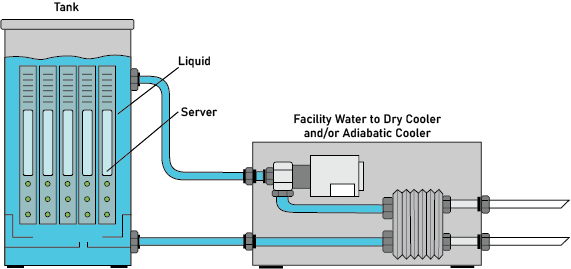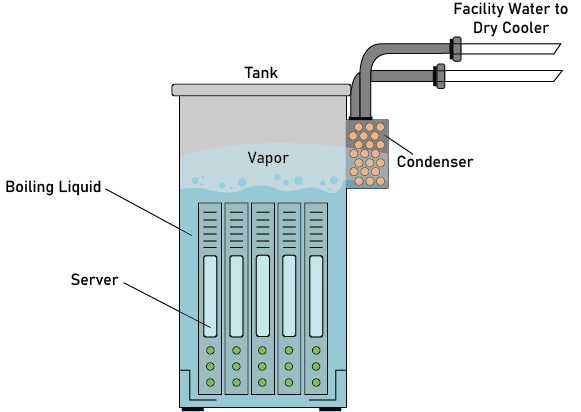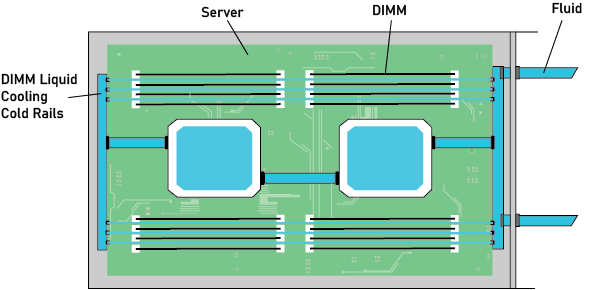Immersion Cooling - Data Centers
SF 188™ Engineered Fluid
SF 188™ Engineered Fluid for Immersion Cooling in Data Centers
With the passage of time and technological progress, the need for more effective and reliable heat transfer solutions has increased. The power density of computer chips has become greater and greater. The workload of data centers has become more and more complex, and the heat load has been increasing. The high energy consumption not only brings high economic expenditures to all units but also causes a great waste of social resources. As a brand-new “black technology,” liquid cooling technology is gradually replacing air cooling and becoming a new type of data center cooling solution.
What is SF 188 Fluid?
SF 188 Engineered Fluid is an environmentally sustainable, affordable heat transfer fluid for two-phase immersion cooling. SF 188 is Globally Sourced and certified by the Standard Fluids Team. For more information, please contact the people you can trust at Standard Fluids Corporation.
Immersion cooling involves the cooling of IT hardware in data centers by submerging the equipment directly into a non-conductive liquid, such as SF 188 fluid. The heat produced by the electronic components is efficiently transferred directly to the fluid, eliminating the requirement for traditional cooling components like interface materials, heat sinks, fans, shrouds, and sheet metal. This method offers a more streamlined and efficient cooling solution compared to conventional approaches.
Raising the STANDARD for Cooling in Data Center Applications
Leveraging SF 188 fluid for immersion cooling can enhance efficiency, cut costs, and decrease reliance on natural resources throughout the entire data center lifecycle — from initial design and construction to ongoing maintenance and operations. The prospect of a state-of-the-art data center is within reach, and Standard Fluids’ scientific expertise is ready to guide you on this journey.
Hyperscale
Optimizing Strategy, Performance, Cost, and Sustainability.
Adaptability Across Geographies and Environments
Effortlessly deploy data centers with a consistently efficient cooling infrastructure worldwide, irrespective of location decisions.
Efficient Scaling through Streamlined Designs
Achieve enhanced scalability with smaller data centers and simplified topologies (mechanical, electrical, networking). Streamline data center designs by eliminating the complexities of airflow management.
Cost-Effective Operations
Address evolving workload requirements while minimizing capital expenditure by reducing or eliminating air-cooling infrastructure (chillers, CRACs, CRAHs, PDUs, RPPs, telecom/networking, facility footprint). Enhanced cooling efficiency leads to reduced electricity costs associated with ancillary cooling needs.
Lower Power Usage Effectiveness (PUE) and Water Consumption
Enable the construction of more power-efficient and sustainable data centers. Additionally, cut down or eliminate water waste by implementing single-phase or two-phase immersion cooling, complemented by the use of dry cooler

Supercomputing
Optimizing Strategy, Performance, Cost, and Sustainability.
Enhanced Performance and Cooling Efficiency
Enable the support of new or more compute-intensive workloads that conventional cooling solutions struggle to efficiently and cost-effectively cool. Achieve this through an increase in floating-point operations per second (FLOPS) per watt.
Operational Cost Reduction
Realize cost savings through increased cooling efficiency, leading to a reduction in electricity costs associated with ancillary cooling needs.

Enterprise HPC
Optimizing Strategy, Performance, Cost, and Sustainability.
Enhanced Power and Cooling Efficiency
Enable the efficient and cost-effective cooling of new or more compute-intensive workloads, addressing challenges faced by traditional cooling solutions.
Reduced Latency
Minimize delays by running latency-sensitive workloads in denser, space-optimized data centers or server closets that are closer to the user.
Improved Hardware Reliability
Enhance the reliability of operations with lower junction temperatures, reduced temperature swings, and diminished hot spots. Mitigate common hardware failures by minimizing the use of moving parts (e.g., fans) required in traditional cooling methods.

Edge/5G
Optimizing Strategy, Performance, Cost, and Sustainability.
Adaptability Across Geographies and Environments
Implement edge systems with uniform cooling infrastructure globally, unaffected by environmental variations (e.g., cold/hot, humid/dry). Compact form factors are also better suited for applications with space and weight constraints.
Future-Ready Power Density
Roll out high-density edge units featuring small form factors designed to seamlessly accommodate current and anticipated workloads.
Reduced Latency
Minimize delays by executing latency-sensitive workloads in denser, space-optimized edge units positioned closer to the end user.
Prolonged Asset Lifespan
Sealed immersion-cooled units shield IT hardware from environmental contaminants like dust and moisture. The decrease in moving parts enhances reliability, thereby extending the life of edge units.

Cryptocurrency
Optimization in Strategy, Performance, Cost, and Sustainability.
Enhanced Performance per Watt
Secure a competitive advantage by employing immersion cooling to amplify hash rates through overclocking. Channel additional power towards mining and other profit-centric operations, leveraging the heightened efficiency in cooling.
Cost and Operational Efficiency
Reduce capital expenditure by streamlining or eliminating air-cooling infrastructure (e.g., chillers, CRACs, CRAHs, PDUs, RPPs, telecom/networking, facility footprint). With the improved cooling efficiency, cut down on electricity costs allocated to ancillary cooling needs.

Liquid Cooling Solutions Enabled by Standard Fluids
Standard Fluids’ innovative fluids support applications in both single-phase and two-phase immersion cooling, as well as single-phase and two-phase direct-to-chip applications.

Single-Phase Immersion Cooling
In single-phase immersion cooling, the fluid remains in its liquid phase. Electronic components are directly immersed in a dielectric liquid within a sealed yet easily accessible enclosure. The heat from electronic components transfers to the fluid, and pumps are often employed to circulate the heated fluid to a heat exchanger. There, it undergoes cooling before being recirculated back into the enclosure.
Standard Fluids has products specifically designed for single-phase immersion cooling (see product line brochure below).
Two-Phase Immersion Cooling
Two-phase immersion cooling involves the boiling and condensation of the fluid, significantly enhancing heat transfer efficiency. Electronic components are immersed in a dielectric liquid within a sealed yet easily accessible enclosure. Heat from the components causes the fluid to boil, generating vapor that rises from the liquid. The vapor then condenses on a heat exchanger (condenser) within the tank, transferring heat to facility water circulating outside the data center.


Direct-to-Chip Cooling
Direct-to-chip cooling expels heat by circulating fluid through cold plates attached to electronic components. While non-dielectric fluids (e.g., water glycol) are common in direct-to-chip cooling, dielectric fluids can be employed in these applications to mitigate leak-related risks, thereby enhancing hardware and IT equipment reliability. Direct-to-chip cooling can be implemented using both single-phase and two-phase technologies.
Discover the right fluid for your liquid cooling needs
Specialty fluids for data center liquid cooling applications
Electronic Liquids
Electronic Liquids have set the industry standard for direct-contact electronics cooling for over 60 years. These extremely inert, fully-fluorinated liquids have exceptionally high dielectric strength and excellent material compatibility. ™ Electronic Liquids are clear, odorless, non-flammable, non-oil-based, low in toxicity, non-corrosive, offer a wide temperature operating range and high thermal and chemical stability.
Engineered Fluids
Engineered Fluids are non-flammable, non-oil-based, low in toxicity, non-corrosive, and have good material compatibility and thermal stability. They also have a low global warming potential (GWP) and zero ozone depletion potential (ODP), giving data center owners an innovative, trusted and sustainable solution for their two-phase immersion cooling and direct-to-chip-cooling applications.
Frequently Asked Questions about Immersion Cooling
Immersion cooling is a technique for cooling data center IT hardware by submerging the equipment directly into a non-conductive liquid, such as SF 188™ Engineered Fluids. The heat generated by electronic components is efficiently transferred directly to the fluid, eliminating the need for traditional cooling components like interface materials, heat sinks, fans, shrouds, and sheet metal.
Immersion cooling with Standard Fluids’ products offers numerous benefits over traditional air cooling, including increased thermal efficiency (lower PUE), enhanced performance, and improved data center reliability. This method eliminates the need for complex airflow management, resulting in reductions in capital and operating expenses. Optimized immersion-cooled data centers allow for more flexible layouts, remove barriers to location choices, and address the tradeoff between water usage, energy efficiency, and cost.
In immersion cooling, IT hardware is directly submerged in a sealed but easily accessible enclosure filled with dielectric liquid. Heat is directly transferred to the fluid. Direct-to-chip cooling, on the other hand, circulates fluid through pipes to cold plates on electronic components, keeping the fluid separate from the electronics. Both methods can be implemented using single-phase and two-phase technologies with Standard Fluids.
There are two common configurations for immersion cooling: tank-style and clamshell. Tank-style immersion cooling utilizes a sealed tank filled with dielectric fluid as the heat transfer medium. Servers are vertically installed inside the tank. Clamshell design involves sealing server electronics within the server chassis, with dielectric fluid circulated through the enclosure. Servers are typically inserted horizontally into a rack.
Considerations include simplicity of tank design, fluid containment, material compatibility, and fluid hygiene for single-phase immersion cooling. Two-phase immersion cooling offers greater heat transfer efficiency, allowing for higher power densities. Additionally, two-phase systems typically require less complex cooling infrastructure.
Both fluorochemicals and hydrocarbons can be used for single-phase immersion cooling. Fluids with a higher boiling point ensure the liquid phase is maintained. Considerations when choosing among various fluids include heat transfer performance, ease of IT hardware maintenance, material compatibility, electrical properties, environmental impact, and total fluid cost over the system's lifetime.
Fluorochemical fluids with lower boiling points are primarily used for two-phase immersion cooling. Hydrocarbons are not typically used for two-phase systems due to their combustible nature. Considerations for fluid selection in two-phase cooling include impact on IT performance, ease of maintenance, material compatibility, electrical properties, environmental impact, safety-related issues, and total fluid cost over the lifetime of the tank or data center.
Strategic Partnerships
E3 NV, LLC

Fike Corporation — Global Headquarters
704 SW 10th Street
Blue Springs, MO 64015
1-800-YES-FIKE
+1-816-229-3405

